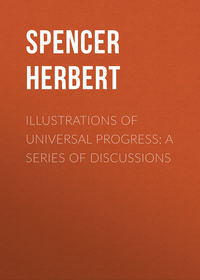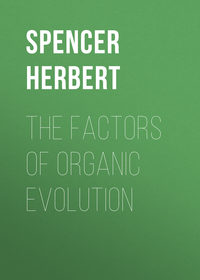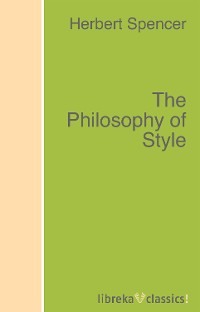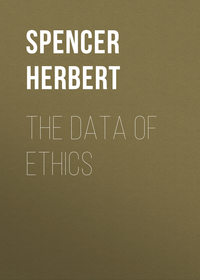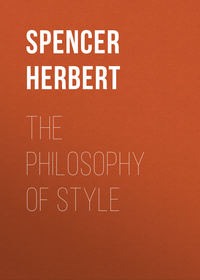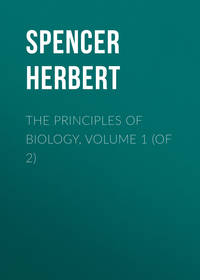 полная версия
полная версияFirst Principles
From that originally molten state of the Earth inferable from established geological data – a state in harmony with the nebular hypothesis but inexplicable on any other – the transition to its existing state has been through stages in which the characters became more determinate. Besides being, as above pointed out, comparatively unstable in surface and contour, a fluid spheroid is less definite than a solid spheroid in having no fixed distribution of parts. Currents of molten matter, though kept to certain general circuits by the conditions of equilibrium, cannot in the absence of solid boundaries be precise or permanent in direction: all parts must be in motion with respect to other parts. But a solidification of the surface, even though but partial, is manifestly a step towards the establishment of definite relations of position. In a thin crust however, frequently ruptured as it must be by disturbing forces, and moved by every tidal undulation, such fixity of relative position can be but temporary. Only as the crust slowly increases in thickness, can there arise distinct and settled geographical relations. Observe too that when, on a crust that has cooled to the requisite degree, there begins to precipitate the water floating above as vapour, the water which is precipitated cannot maintain any definiteness either of state or place. Falling on a surface not thick enough to preserve anything beyond slight variations of level, it must form small shallow deposits over areas sufficiently cool to permit condensation; which areas must not only pass insensibly into others that are too hot for this, but must themselves from time to time be so raised in temperature as to drive off the water lying on them. With progressive refrigeration, however, – with an increasing thickness of crust, a consequent formation of larger elevations and depressions, and the condensation of more atmospheric water, there comes an arrangement of parts that is comparatively fixed in both time and space; and the definiteness of state and position increases, until there results such a distribution of continents and oceans as we now see – a distribution that is not only topographically precise, but also in its cliff-marked coast-lines presents a more definite division of land from water than could have existed during the period when islands of low elevation had shelving beaches up which the tide ebbed and flowed to great distances. Respecting the characteristics technically classed as geological, we may draw parallel inferences. While the Earth’s crust was thin, mountain-chains were impossibilities: there could not have been long and well-defined axes of elevation, with distinct water-sheds and areas of drainage. Moreover, from small islands admitting of but small rivers, and tidal streams both feeble and narrow, there would result no clearly-marked sedimentary strata. Confused and varying masses of detritus, such as those now found at the mouths of brooks, must have been the prevailing formations. And these could give place to distinct strata, only as there arose continents and oceans, with their great rivers, long coast-lines, and wide-spreading marine currents. How there must simultaneously have resulted more definite meteorological characters, need not be pointed out in detail. That differences of climates and seasons must have grown relatively decided as the heat of the Sun became distinguishable from the proper heat of the Earth; that the establishment through this cause of comparatively constant atmospheric currents, must have similarly produced more specific conditions in each locality; and that these effects must have been aided by increasing permanence in the distribution of land and sea and of ocean currents; are conclusions which are sufficiently obvious.
Let us turn now to the evidence furnished by organic bodies. In place of deductive illustrations like the foregoing, we shall here find numerous illustrations which, as being inductively established, are less open to criticism. The process of mammalian development, for example, will supply us with numerous proofs ready-described by embryologists. The first change which the ovum of a mammal undergoes, after continued segmentation has reduced its yelk to a mulberry-like mass, is the appearance of a greater definiteness in the peripheral cells of this mass: each of which acquires a distinct enveloping membrane. These peripheral cells, vaguely distinguished from the internal ones both by their greater completeness and by their minuter subdivision, coalesce to form the blastoderm or germinal membrane. One portion of the blastoderm presently becomes contrasted with the rest, through the accumulation of cells still more subdivided, which, together, form an opaque roundish spot. This area germinativa, as it is called, is not sharply delineated, but shades off gradually into the surrounding parts of the blastoderm; and the area pellucida, subsequently formed in the midst of this germinal area, is similarly without any precise margin. The “primitive trace,” which makes its appearance in the centre of the area pellucida, and is the rudiment of that vertebrate axis which is to be the fundamental characteristic of the mature animal, is shown by its name to be at first indefinite – a mere trace. Beginning as a shallow groove, this becomes slowly more pronounced: its sides grow higher, their summits overlap, and at last unite; and so the indefinite groove passes into a definite tube, forming the vertebral canal. In this vertebral canal the leading divisions of the brain are at first discernible only as slight bulgings; while the vertebræ commence as indistinct modifications of the tissue bounding the canal. Simultaneously, the outer portion of the blastoderm has been undergoing separation from the inner portion: there has been a division into the serous and mucous layers – a division at the outset indistinct, and traceable only about the germinal area, but which insensibly spreads throughout nearly the whole germinal membrane, and becomes definite. From the mucous layer, the development of the alimentary canal proceeds as that of the vertebral canal does from the serous layer. Originally a simple channel along the under surface of the embryonic mass, the intestine is rendered step by step more distinct by the bending down, on each side, of ridges which finally join to form a tube – the permanent absorbing surface is by degrees clearly cut off from that temporary absorbing surface of which it was at first a part like all the rest. And in an analogous manner the entire embryo, which at first lies outspread upon the surface of the yelk-sack, gradually rises up from it, and, by the infolding of its ventral surface, becomes a separate mass, connected with the yelk-sack only by a narrow duct. These changes through which the general structure of the embryo is marked out with slowly-increasing precision, are paralleled in the evolution of each organ. The heart is at first a mere aggregation of cells, of which the inner liquify to form the cavity, while the outer are transformed into the walls; and when thus sketched out, the heart is indefinite not only as being unlined by limiting membrane, but also as being but vaguely distinguishable from the great blood-vessels: of which it is little more than a dilatation. By and by the receiving portion of the cavity becomes distinct from the propelling portion. Afterwards there begins to be formed across the ventricle, a septum, which, however, is some time before it completely shuts off the two halves from each other; while the later-formed septum of the auricle remains incomplete during the whole of fœtal life. Again, the liver commences as a multiplication of certain cells in the wall of the intestine. The thickening produced by this multiplication “increases so as to form a projection upon the exterior of the canal;” and at the same time that the organ grows and becomes distinct from the intestine, the channels which permeate it are transformed into ducts having clearly-marked walls. Similarly, by the increase of certain cells of the external coat of the alimentary canal at its upper portion, are produced buds from which the lungs are developed; and these, in their general outlines and detailed structure, acquire distinctness step by step. Changes of this order continue long after birth; and, in the human being, are some of them not completed till middle life. During youth, most of the articular surfaces of the bones remain rough and fissured – the calcareous deposit ending irregularly in the surrounding cartilage. But between puberty and the age of thirty, the articular surfaces are finished off by the addition of smooth, hard, sharply-cut “epiphyses.” Thus we may say that during Evolution, an increase of definiteness continues long after there ceases to be any appreciable increase of heterogeneity. And, indeed, there is reason to think that those structural modifications which take place after maturity, ending in old age and death, are modifications of this nature; since they result in a growing rigidity of structure, a consequent restriction of movement and of functional pliability, a gradual narrowing of the limits within which the vital processes go on, ending at length in an organic adjustment too precise – too narrow in its margin of possible variation to permit the requisite adaptation to external changes of condition.
To demonstrate that the Earth’s Flora and Fauna, regarded either as wholes or in their separate species, have progressed in definiteness, is of course no more possible than it was to demonstrate that they have progressed in heterogeneity: lack of facts being an obstacle to the one conclusion as to the other. If, however, we allow ourselves to reason from the hypothesis, now daily rendered more probable, that every species of organic form up to the most complex, has arisen out of the simplest through the accumulation of modifications upon modifications, just as every individual organic form arises; we shall see that in such case there must have been a progress from the indeterminate to the determinate, both in the particular forms and in the groups of forms. We may set out with the significant fact that many of the lowest living organisms (which are analogous in structure to the germs of all higher ones) are so indefinite in character that it is difficult, if not impossible, to decide whether they are plants or animals. Respecting sundry of them there are unsettled disputes between zoologists and botanists; and it has even been proposed to group them into a separate kingdom, forming a common basis to the animal and vegetal kingdoms. Note next that among the Protozoa, extreme indefiniteness of shape is very general. In the shell-less Rhizopods and their allies, not only is the form so irregular as to admit of no description, but it is neither alike in any two individuals nor in the same individual at successive moments. By the aggregation of such creatures, are produced, among other indefinite bodies, the sponges – bodies that are indefinite in size, in contour, in internal arrangement, and in the absence of an external limiting membrane. As further showing the relatively indeterminate character of the simplest organisms, it may be mentioned that their structures vary very greatly with surrounding conditions: so much so that, among the Protozoa and Protophyta, many forms which were once classed as distinct species, and even as distinct genera, are found to be merely varieties of one species. If now we call to mind how precise in their attributes are the highest organisms – how sharply cut their outlines, how invariable their proportions, and how comparatively constant their structures under changed conditions, we cannot deny that greater definiteness is one of their characteristics; and that if they have been evolved out of lower organisms, an increase of definiteness has been an accompaniment of their evolution. That in course of time, species have become more sharply marked off from other species, genera from genera, and orders from orders, is a conclusion not admitting of a more positive establishment than the foregoing; and must, indeed, stand or fall with it. If, however, species and genera and orders have resulted from the process of “natural selection,” then, as Mr. Darwin shows, there must have been a tendency to divergence, causing the contrasts between groups to become more and more pronounced. By the disappearance of intermediate forms, less fitted for special spheres of existence than the extreme forms they connected, the differences between the extreme forms must be rendered more decided; and so, from indistinct and unstable varieties, must slowly be produced distinct and stable species. Of which inference it may be remarked, not only that it follows from a process to which the organic creation is of necessity ever subject, but also that it is in harmony with what we know respecting races of men and races of domestic animals.
Evidence that in the course of psychial development, there is a change from the vague to the distinct, may be seen in every nursery. The confusion of the infant’s perceptions is shown by its inability to distinguish persons. The dimness of its ideas of direction and distance, may be inferred from the ill-guided movements of its hands, and from its endeavours to grasp objects far out of reach. Only by degrees does the sense of equilibrium, needful for safe standing and moving, gain the requisite precision. Through the insensible steps that end in comprehensible speech, we may trace an increase in the accuracy with which sounds are discriminated and in the nicety with which they are imitated. And similarly during education, the change is towards the establishment of internal relations more perfectly corresponding to external ones – to exactness in calculations, to a better representation of objects drawn, to a more correct spelling, to a completer conformity to the rules of speech, to clearer ideas respecting the affairs of life. How in the further progress to maturity the law still holds, needs not here be pointed out; more especially as it will presently be shown in treating of the evolution of intelligence during the advance of civilization. The only further fact calling for remark, is, that this increase of mental definiteness is, in some ways, manifested even during the advance from maturity to old age. The habits of life grow more and more fixed; the character becomes less capable of change; the quantity of knowledge previously acquired ceases to have its limits alterable by additions; and the opinions upon every point admit of no modification.
Still more manifestly do the successive phases through which societies pass, display the progress from indeterminate arrangement to determinate arrangement. A wandering tribe of savages, as being fixed neither in its locality nor in the relative positions of its parts, is far less definite than a nation, covering a territory clearly marked out, and formed of individuals grouped together in towns and villages. In such a tribe the social relations are similarly confused and unsettled. Political authority is neither well established nor precise. Distinctions of rank are neither clearly marked nor impassable. “Medicine-men” and “rain-makers” form a class by no means as distinct from the rest of the community as eventually becomes the priesthood they foreshadow. And save in the different occupations of men and women, there are no complete industrial divisions. Only in tribes of considerable size, which have enslaved other tribes, is the economical differentiation decided. Any one of these primitive societies however that developes, becomes step by step more specific. Increasing in size, consequently ceasing to be so nomadic, and restricted in its range by neighbouring tribes, it acquires, after prolonged border warfare, a more settled territorial boundary. The distinction between the royal race and the people, grows so extreme as to amount in the popular apprehension to a difference of nature. The warrior-class attains a perfect separation from classes devoted to the cultivation of the soil or other occupations regarded as servile. And there arises a priesthood that is defined in its rank, its functions, its privileges. This sharpness of definition, growing both greater and more variously exemplified as societies advance to maturity, is extremest in those that have reached their full development or are declining. Of ancient Egypt we read that its social divisions were strongly-marked and its customs rigid. Recent investigations make it more than ever clear, that among the Assyrians and surrounding peoples, not only were the laws unalterable, but even the minor habits, down to those of domestic routine, possessed a sacredness which insured their permanence. In India at the present day, the unchangeable distinctions of caste, not less than the constancy in modes of dress, industrial processes, and religious observances, show us how fixed are the arrangements where the antiquity is great. Nor does China with its long-settled political organization, its elaborate and precise conventions, and its unprogressive literature, fail to exemplify the same truth. The successive phases of our own and neighbouring societies, furnish facts somewhat different in kind but similar in meaning. After our leading class-divisions had become tolerably well-established, it was long before they acquired their full precision. Originally, monarchical authority was more baronial, and baronial authority more monarchical, than they afterwards became. Between modern priests and the priests of old times, who while officially teachers of religion were also warriors, judges, architects, there is a marked difference in definiteness of function. And among the people engaged in productive occupations, the like contrast would be found to hold: the industrial office has become more distinct from the military; and its various divisions from each other. A history of our constitution, reminding us how, after prolonged struggles, the powers of King, Lords, and Commons, have been gradually settled, would clearly exhibit analogous changes. Countless facts bearing the like construction would meet us, were we to trace the development of legislation: in the successive stages of which, we should find statutes made more precise in their provisions – more specific in their applications to particular cases. Even at the present time we see that each new law, beginning as a vague proposition, is, in the course of enactment, elaborated into specific clauses; and further that only after its interpretation has been established by judges’ decisions in courts of justice, does it reach its final definiteness. From the history of minor institutions like evidence may be gathered. Religious, charitable, literary, and all other societies, beginning with ends and methods roughly sketched out and easily modifiable, show us how, by the accumulation of rules and precedents, the purposes become more distinct and the modes of action more restricted; until at last death often results from a fixity which admits of no adaptation to new conditions. Should it be objected that among civilized nations there are examples of decreasing definiteness, (instance the breaking down of limits between ranks,) the reply is, that such apparent exceptions are the accompaniments of a social metamorphosis – a change from the military or predatory type of social structure, to the industrial or mercantile type, during which the old lines of organization are disappearing and the new ones becoming more marked.
That all organized results of social action, pass in the course of civilization through parallel phases, is demonstrable. Being, as they are, objective products of subjective processes, they must display corresponding changes; and that they do this, the cases of Language, of Science, of Art, clearly prove.
If we strike out from our sentences everything but nouns and verbs, we shall perceive how extremely vague is the expression of ideas in undeveloped tongues. When we note how each inflection of a verb or addition by which the case of a noun is marked, serves to limit the conditions of action or of existence, we see that these constituents of speech enable men more precisely to communicate their thoughts. That the application of an adjective to a noun or an adverb to a verb, narrows the class of things or changes indicated, implies that these additional words serve further to define the meaning. And similarly with other parts of speech. The like effect results from the multiplication of words of each order. When the names for objects, and acts, and qualities, are but few, the range of each is proportionately wide, and its meaning therefore unspecific. The similes and metaphors so abundantly used by aboriginal races, are simply vehicles for indirectly and imperfectly conveying ideas, which lack of words disables them from conveying directly and perfectly. In contrasting these figurative expressions, interpretable in various senses, with the expressions which we should use in place of them, the increase of exactness which wealth of language gives, is rendered very obvious. Or to take a case from ordinary life, if we compare the speech of the peasant, who, out of his limited vocabulary, can describe the contents of the bottle he carries, only as “doctor’s-stuff” which he has got for his “sick” wife, with the speech of the physician, who tells those educated like himself the particular composition of the medicine, and the particular disorder for which he has prescribed it; we have vividly brought home to us, the precision which language gains by the multiplication of terms. Again, in the course of its evolution, each tongue acquires a further accuracy through processes which fix the meaning of each word. Intellectual intercourse tends gradually to diminish laxity of expression. By and by dictionaries give definitions. And eventually, among the most cultivated, indefiniteness is not tolerated, either in the terms used or in their grammatical combinations. Once more, languages considered as wholes, become gradually more distinct from each other, and from their common parent: as witness in early times the divergence from the same root of two languages so unlike as Greek and Latin, and in later times the development of three Latin dialects into Italian, French, and Spanish.
In his “History of the Inductive Sciences,” Dr. Whewell says that the Greeks failed in physical philosophy because their “ideas were not distinct, and appropriate to the facts.” I do not quote this remark for its luminousness; since it would be equally proper to ascribe the indistinctness and inappropriateness of their ideas to the imperfection of their physical philosophy; but I quote it because it serves as good evidence of the indefiniteness of primitive science. The same work and its fellow on “The Philosophy of the Inductive Sciences,” supply other evidences equally good, because equally independent of any such hypothesis as is here to be established. Respecting mathematics we have the fact that geometrical theorems grew out of empirical methods; and that these theorems, at first isolated, did not acquire the clearness which complete demonstration gives, until they were arranged by Euclid into a series of dependent propositions. At a later period the same general truth was exemplified in the progress from the “method of exhaustions” and the “method of indivisibles” to the “method of limits;” which is the central idea of the infinitesimal calculus. In early mechanics, too, may be traced a dim perception that action and re-action are equal and opposite; though for ages after, this truth remained unformulated. And similarly, the property of inertia, though not distinctly comprehended until Kepler lived, was vaguely recognized long previously. “The conception of statical force,” “was never presented in a distinct form till the works of Archimedes appeared;” and “the conception of accelerating force was confused, in the mind of Kepler and his contemporaries, and did not become clear enough for purposes of sound scientific reasoning before the succeeding century.” To which specific assertions may be added the general remark, that “terms which originally, and before the laws of motion were fully known, were used in a very vague and fluctuating sense, were afterwards limited and rendered precise.” When we turn from abstract scientific conceptions to the concrete previsions of science, of which astronomy furnishes us with numerous examples, the like contrast is visible. The times at which celestial phenomena will occur, have been predicted with ever-increasing accuracy: errors once amounting to days, have been reduced down to seconds. The correspondence between the real and supposed forms of orbits, has been growing gradually more precise. Originally thought circular, then epicyclical, then elliptical, orbits are now ascertained to be curves which always deviate more or less from perfect ellipses, and which are ever undergoing change. But the general advance of Science in definiteness, is best shown by the contrast between its qualitative stage, and its quantitative stage. At first, the facts ascertained were, that between such and such phenomena some connexion existed – that the appearances a and b always occurred together or in succession; but it was neither known what was the nature of the relation between a and b, nor how much of a accompanied so much of b. The development of Science has in part been the reduction of these vague connexions to distinct ones. Most relations have been determined as belonging to the classes mechanical, chemical, thermal, electric, magnetic, &c.; and we have learnt to infer the amounts of the antecedents and consequents from each other with an exactness that becomes ever greater. Were there space to state them, illustrations of this truth might be cited from all departments of physics; but it must suffice here to instance the general progress of chemistry. Besides the conspicuous fact that we have positively ascertained the constituent elements of an immense number of compounds which our ancestors could not analyze, and of a far greater number which they never even saw, there is the still more conspicuous fact that the combining equivalents of these elements are accurately calculated. The beginnings of a like advance from qualitative to quantitative prevision, may be traced even in some of the higher sciences. Physiology shows it in the weighing and measuring of organic products, and of the materials consumed. By Pathology it is displayed in the use of the statistical method of determining the sources of diseases, and the effects of treatment. In Zoology and Botany, the numerical comparisons of Floras and Faunas, leading to specific conclusions respecting their sources and distributions, illustrate it. And in Sociology, questionable as are the conclusions usually drawn from the classified sum-totals of the census, from Board-of-Trade tables, and from criminal returns, it must be admitted that these imply a progress towards more accurate conceptions of social phenomena. That an essential characteristic of advancing Science is increase in definiteness, appears indeed almost a truism, when we remember that Science may be described as definite knowledge, in contradistinction to that indefinite knowledge possessed by the uncultured. And if, as we cannot question, Science has, in the slow course of ages, been evolved out of this indefinite knowledge of the uncultured; then, the gradual acquirement of that great definiteness which now distinguishes it, must have been a leading trait in its evolution.



